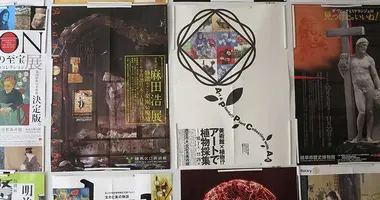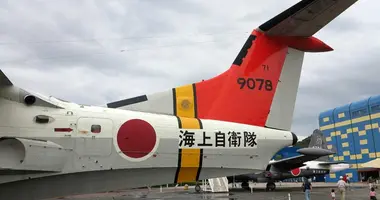Nagaragawa Ukai Museum
- History of Ukai Cormorant Fishing in Gifu
- Nagaragawa Ukai Museum Exhibits
- Nagaragawa Ukai Museum Access
- Gifu Museums
- Japan Museums
Nagaragawa Ukai Museum, Gifu 長良川うかいミュージアム, 岐阜
The Nagaragawa Ukai Museum is located on the north bank of the Nagara River in the historic cormorant fishermens' quarter in Gifu city.
The modern museum opened in 2012 and is recommended for visitors who are going to participate in the ukai (cormorant fishing) after dark on the Nagara River, in order to learn something of the history, traditions and techniques of the experience.

Nagaragawa Ukai Museum, Gifu

Guidance Theater "Welcome to Nagaragawa Ukai", Nagaragawa Ukai Museum, Gifu
History of Ukai Cormorant Fishing in Gifu
The Nagaragawa Ukai Museum is dedicated to the tradition of ukai (鵜飼) - fishing for ayu sweetfish with trained cormorants in the waters of the Nagara River in Gifu.
The tradition of cormorant fishing is believed to arrived from China and has a history of around 1,300 years in Gifu.
The cormorants are controlled by a master fisherman (usho), who lives with the birds to train them and traditionally passes down his skills to one of his sons. presently there are six families of usho, each with their own family crest (mon). The usho live in the area near the Nagaragawa Ukai Museum and their houses are marked by signboards.

Family Crests of the usho, Nagaragawa Ukai Museum, Gifu

Family Crests of the usho, Nagaragawa Ukai Museum, Gifu
During the Edo Period watching the ukai fishing in boats was a popular pastime, often represented in wood-block prints.
Some of the fish caught were sent to the local Owari daimyo (feudal lord) in nearby Nagoya and even as far as the shogun in Edo (Tokyo). After the Meiji Restoration and the demise of the Tokugawa regime, the shogun and his vassals, the cormorant fishermen fell on hard times.
The Emperor Meiji was made aware of their plight and they became "Imperial Fishermen of the Royal Household Agency" in order to preserve their profession.
As well as the Emperor Meiji, other historical figures to be fascinated by the practice include local warlord Oda Nobunaga, the first Tokugawa shogun Tokugawa Ieyasu, the haiku poet Matsuo Basho, who wrote on the subject and the comedian Charlie Chaplin.
Nowadays in Gifu, cormorant fishing takes place after nightfall at around 7.30pm in the summer from May 11 - October 15 except on nights with a full moon or in heavy rain.
Each usho, dressed in traditional costume with a tall hat and straw skirt, manipulates 10-12 cormorants using ropes, while the only illumination is the pine torches on the boats.

Kagaribi Flame-lit Tunnel, Nagaragawa Ukai Museum, Gifu

Scenic Lounge, Nagaragawa Ukai Museum, Gifu
Nagaragawa Ukai Museum Exhibits
The Nagaragawa Ukai Museum opened in 2012 and aims to provide information on ukai cormorant fishing as well as "ensure the inheritance of Nagaragawa ukai for the next generation."
The modern museum is set on two floors. Visitors pass through a scenic lounge overlooking the river, then the impressive kagaribi flame-lit tunnel representing the six families of usho.
The guidance theater is a picture scroll shaped screen that presents a video (with English sub-titles) on the history and practice of ukai cormorant fishing. The authentic sound effects and lighting superbly capture the experience with life-sized boats and mannequins.
A special exhibition room (with no photography) explores the world of Japanese boat building, a closely guarded secret passed down from master to apprentice. Japanese Wooden Boatbuilding by American author and boat builder Douglas Brooks delves into this secret art.
The first floor of the museum has more close-up video of the cormorants actually catching the fish and a section dedicated to the costumes, crests and formal conduct of the usho master fishermen.
Further sections of the museum include interactive, quiz-like exhibits aimed at the young, including a huge (4 times life size) model of a cormorant, introducing the birds' anatomy and behaviour and also a section on the crystal clear Nagara River and the ayu fish that inhabit its waters.
The Nagaragawa Ukai Museum also includes a museum shop selling local delicacies and souvenirs, the Clover Coffee Nagara cafe, which becomes a beer garden in summer and an Exchange and Experience Plaza hosting local events in the garden outside. Also in the grounds is the Cormorant Ecology Exhibition Space where you can see live cormorants used in breeding.
The cafe, Exchange and Experience Plaza and Scenic Lounge all have excellent views of Gifu Castle and Mt. Kinka as well as the river below.
The Scenic Lounge with its woody interior and special views is also used for a variety of events including yoga classes.

Multimedia display, Nagaragawa Ukai Museum, Gifu

Exhibits, Nagaragawa Ukai Museum, Gifu
Nagaragawa Ukai Museum Access
Nagaragawa Ukai Museum (ukaimuseum.jp)
51-2 Nagara
Gifu City, Gifu Prefecture
502-0071
Tel: 058 210 1555
Hours: 9 am-7 pm May 1-October 15 (open every day); 9 am-5 pm October 16-April 30. (Closed Tuesday or the next day if Tuesday is a national holiday. Closed December 29-January 3.
Admission to Nagaragawa Ukai Museum is 500 yen for adults and 250 yen for children under 15 years of age.
Nagaragawa Ukai Museum is located north east of JR Gifu Station. Take a bus from JR Gifu Station or Meitetsu Gifu Station and alight at the Ukaiya stop on the north side of Nagarabashi Bridge. The bus fare is 210 yen for adults; 100 yen for children.
Nagaragawa Ukai Museum is across the river from Gifu Park and its museums: Nawa Insect Museum, Kato Eizo-Toichi Memorial Art Museum and Gifu City Museum of History. The museum is also close to Shinmei Jinja and a number of places to stay including Ishikin Ryokan, Usho-no-Ie Sugiyama and the large Gifu Grand Hotel. Across the river on the south bank is the Hotel Park with an indoor and outdoor hot spring bath.

Exhibits, Nagaragawa Ukai Museum, Gifu
Books on Japan
The Nagaragawa Ukai Museum in Gifu is dedicated to the historic practice of cormorant fishing (ukai) in the Nagara River just below the museum.

















